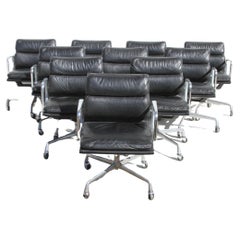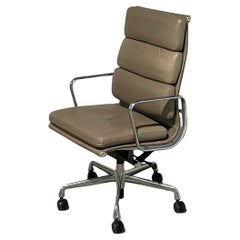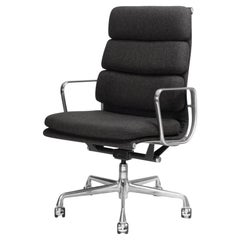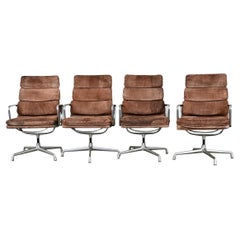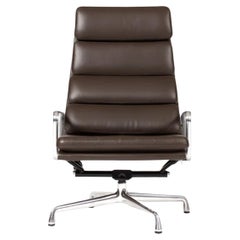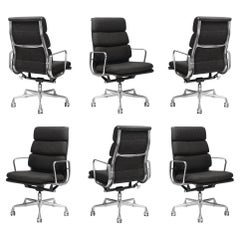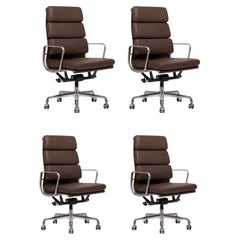Eames Soft Pad
Late 20th Century American Mid-Century Modern Office Chairs and Desk Chairs
Leather
Vintage 1950s American Craftsman Office Chairs and Desk Chairs
Leather
21st Century and Contemporary American Mid-Century Modern Office Chairs ...
Leather
Early 2000s American Mid-Century Modern Office Chairs and Desk Chairs
Aluminum
Early 2000s American Mid-Century Modern Office Chairs and Desk Chairs
Aluminum
20th Century American Mid-Century Modern Armchairs
Aluminum
21st Century and Contemporary American Mid-Century Modern Lounge Chairs
Leather
Early 2000s American Mid-Century Modern Office Chairs and Desk Chairs
Aluminum
21st Century and Contemporary American Mid-Century Modern Office Chairs ...
Leather
Vintage 1980s American Modern Office Chairs and Desk Chairs
Aluminum
2010s American Modern Office Chairs and Desk Chairs
Aluminum, Steel
2010s American Modern Office Chairs and Desk Chairs
Aluminum, Steel
2010s American Modern Office Chairs and Desk Chairs
Aluminum
Vintage 1970s American Modern Office Chairs and Desk Chairs
Aluminum, Steel
Vintage 1980s American Modern Office Chairs and Desk Chairs
Aluminum
Early 2000s American Modern Office Chairs and Desk Chairs
Aluminum, Steel
1990s American Modern Office Chairs and Desk Chairs
Aluminum, Steel
Vintage 1970s American Modern Office Chairs and Desk Chairs
Aluminum, Steel
2010s American Modern Office Chairs and Desk Chairs
Aluminum, Steel
1990s American Modern Office Chairs and Desk Chairs
Aluminum
2010s American Modern Office Chairs and Desk Chairs
Aluminum, Steel
21st Century and Contemporary American Modern Office Chairs and Desk Chairs
Aluminum
21st Century and Contemporary American Modern Office Chairs and Desk Chairs
Aluminum
2010s American Modern Office Chairs and Desk Chairs
Aluminum
2010s American Modern Office Chairs and Desk Chairs
Aluminum
21st Century and Contemporary American Mid-Century Modern Office Chairs ...
Aluminum, Steel
Late 20th Century American Mid-Century Modern Office Chairs and Desk Chairs
Aluminum, Steel
2010s American Modern Office Chairs and Desk Chairs
Aluminum
Early 2000s American Modern Lounge Chairs
Aluminum, Steel
1990s American Modern Lounge Chairs
Aluminum
Vintage 1970s American Modern Office Chairs and Desk Chairs
Aluminum
2010s American Modern Office Chairs and Desk Chairs
Aluminum
21st Century and Contemporary American Modern Office Chairs and Desk Chairs
Aluminum
2010s American Modern Office Chairs and Desk Chairs
Aluminum
Early 2000s North American Modern Office Chairs and Desk Chairs
Aluminum
2010s American Modern Office Chairs and Desk Chairs
Aluminum
1990s American Modern Chairs
Metal
2010s American Modern Lounge Chairs
Aluminum
2010s American Modern Office Chairs and Desk Chairs
Aluminum, Steel
2010s American Modern Office Chairs and Desk Chairs
Aluminum, Steel
Vintage 1970s American Modern Lounge Chairs
Aluminum
Mid-20th Century American Mid-Century Modern Chairs
Aluminum
21st Century and Contemporary American Office Chairs and Desk Chairs
Leather
Early 2000s American Office Chairs and Desk Chairs
Aluminum
2010s American Office Chairs and Desk Chairs
Aluminum
Vintage 1960s American Mid-Century Modern Office Chairs and Desk Chairs
Chrome
Early 2000s American Office Chairs and Desk Chairs
Aluminum
Vintage 1970s American Mid-Century Modern Swivel Chairs
Metal, Chrome
20th Century American Mid-Century Modern Office Chairs and Desk Chairs
Chrome
Late 20th Century American Mid-Century Modern Office Chairs and Desk Chairs
Chrome
Mid-20th Century Chairs
Aluminum
21st Century and Contemporary Swiss Modern Chairs
Metal
Mid-20th Century American Mid-Century Modern Chairs
Aluminum
Early 2000s American Mid-Century Modern Office Chairs and Desk Chairs
Aluminum, Steel
21st Century and Contemporary American Mid-Century Modern Office Chairs ...
Aluminum, Steel
Vintage 1960s American Armchairs
Chrome
Vintage 1960s Italian Armchairs
Steel
Antique 1650s American Mid-Century Modern Office Chairs and Desk Chairs
Chrome
- 1
Eames Soft Pad For Sale on 1stDibs
How Much is a Eames Soft Pad?
Finding the Right Seating for You
With entire areas of our homes reserved for “sitting rooms,” the value of quality antique and vintage seating cannot be overstated.
Fortunately, the design of side chairs, armchairs and other lounge furniture — since what were, quite literally, the early perches of our ancestors — has evolved considerably.
Among the earliest standard seating furniture were stools. Egyptian stools, for example, designed for one person with no seat back, were x-shaped and typically folded to be tucked away. These rudimentary chairs informed the design of Greek and Roman stools, all of which were a long way from Sori Yanagi's Butterfly stool or Alvar Aalto's Stool 60. In the 18th century and earlier, seats with backs and armrests were largely reserved for high nobility.
The seating of today is more inclusive but the style and placement of chairs can still make a statement. Antique desk chairs and armchairs designed in the style of Louis XV, which eventually included painted furniture and were often made of rare woods, feature prominently curved legs as well as Chinese themes and varied ornaments. Much like the thrones of fairy tales and the regency, elegant lounges crafted in the Louis XV style convey wealth and prestige. In the kitchen, the dining chair placed at the head of the table is typically reserved for the head of the household or a revered guest.
Of course, with luxurious vintage or antique furnishings, every chair can seem like the best seat in the house. Whether your preference is stretching out on a plush sofa, such as the Serpentine, designed by Vladimir Kagan, or cozying up in a vintage wingback chair, there is likely to be a comfy classic or contemporary gem for you on 1stDibs.
With respect to the latest obsessions in design, cane seating has been cropping up everywhere, from sleek armchairs to lounge chairs, while bouclé fabric, a staple of modern furniture design, can be seen in mid-century modern, Scandinavian modern and Hollywood Regency furniture styles.
Admirers of the sophisticated craftsmanship and dark woods frequently associated with mid-century modern seating can find timeless furnishings in our expansive collection of lounge chairs, dining chairs and other items — whether they’re vintage editions or alluring official reproductions of iconic designs from the likes of Hans Wegner or from Charles and Ray Eames. Shop our inventory of Egg chairs, designed in 1958 by Arne Jacobsen, the Florence Knoll lounge chair and more.
No matter your style, the collection of unique chairs, sofas and other seating on 1stDibs is surely worthy of a standing ovation.

